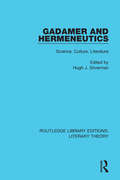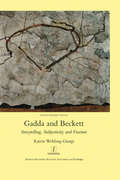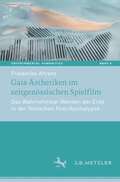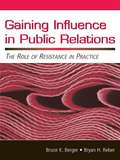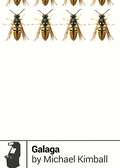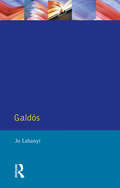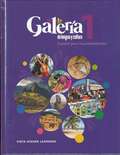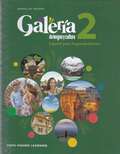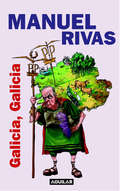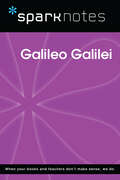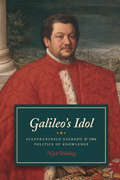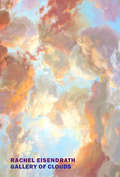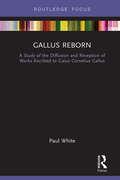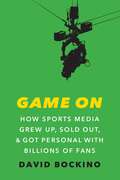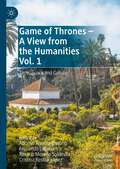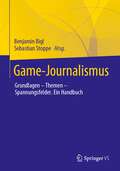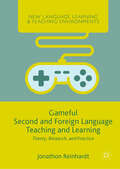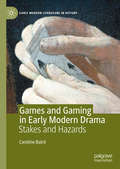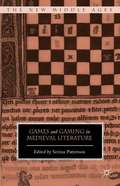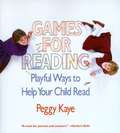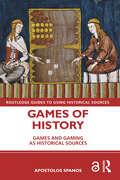- Table View
- List View
Gadamer and Hermeneutics: Science, Culture, Literature (Routledge Library Editions: Literary Theory #12)
by Hugh J. SilvermanThis title, first published in 1991, opens with an account by Gadamer of his own life and work and their relation to the achievements of hermeneutics. Building upon the key theme of dialogue, Gadamer and Hermeneutics provides a series of essays, either linked Gadamer to other major contemporary philosophers or focusing on a given Gadamerian theme. This book will be of interest to students of literary theory.
Gadda and Beckett: Storytelling, Subjectivity And Fracture
by Katrin Wehling-Giorgi"While the writing of Carlo Emilio Gadda (1893-1973) is renowned for its linguistic and narrative proliferation, the best-known works of Samuel Beckett (1906-89) are minimalist, with a clear fondness for subtraction and abstraction. Despite these face-value differences, a close reading of the two authors' early prose writings reveals some surprisingly affinitive concerns, rooted in their profoundly troubled relationship with the literary medium and an unceasing struggle for expression of an incoherent reality and a similarly unfathomable self. Situating Gadda and Beckett at the heart of the debate of late European modernism, this study not only contests the position of'insularity' frequently ascribed to both authors by critical consensus, but it also rethinks some of Gadda's plurilingual and macaronic features by situating them in the context of the turn-of-the-century Sprachkrise, or crisis of language. In a close analysis of the primary texts which engages with the latest findings in empirical research, Wehling-Giorgi casts fresh light on the central notions of textual and linguistic fragmentation and provides a new post-Lacanian analysis of the fractured self in Gadda's and Beckett's narrative."
Gaelic Gold: A Learner's Dictionary/Phrasebook
by Lexus Elfreda Crehan Peter Terrell Steaphan MacrisnidhThe Gaelic Gold learner's dictionary and phrasebook gives you a detailed yet easy-to-use A to Z list of English words and phrases with Scottish Gaelic translations for quick-find reference. There are more than 6000 words and phrases, vocabulary for modern 21st century life; and the Gaelic translations come together with an easy-to-read pronunciation guide. Special features are useful language notes explaining and illustrating basic features of the Gaelic language; typical replies to commonly asked questions; dialogues in English and Gaelic; tables of irregular verbs and prepositional pronouns. You can use this new book to learn a few Gaelic phrases; or you can use it as a tool for learning the language. As the Gaels say: one language is not enough!
Gaia-Ästhetiken im zeitgenössischen Spielfilm: Das Wahrnehmbar-Werden der Erde in der filmischen Post/Apokalypse (Environmental Humanities #4)
by Friederike AhrensGaia-Ästhetiken entwerfen Figurationen der Erde und ihrer Lebensformen, welche die Menschen dezentrieren und den Fokus auf die Verbindungen zwischen Lebewesen untereinander und dem Unbelebten richten. Diese Ästhetiken sind der Gaia-Theorie entlehnt. In den 1970er Jahren bei der NASA entwickelt, wird sie von Bruno Latour und Isabelle Stengers in den Kontext des Anthropozäns gesetzt. Die Erde als Gaia ist eine mehr-als-menschliche Assemblage, in der die Menschen Knotenpunkte der Verantwortlichkeit darstellen. Filmische Ästhetiken können diese Knotenpunkte wahrnehmbar werden lassen, wie die Spielfilme I Am Legend (2007) und Planet of the Apes (2011-2017) zeigen. Die Filme präsentieren ihren Zuschauer_innen eine Welt in der Post/Apokalypse, in der die Filmfiguren mit dem Eindringen Gaias konfrontiert sind. Sie werden in der Post/Apokalypse kompostiert: Viren dringen in ihre Körper ein, zersetzen ihre Menschlichkeit und lassen sie zum Teil des mehr-als-menschlichen Gaia-Komposts werden.
Gaining Influence in Public Relations: The Role of Resistance in Practice (Routledge Communication Series)
by Bryan H. Reber Bruce K. BergerGaining Influence in Public Relations explores how professionals can increase their influence in practice to help their organizations achieve success. This provocative book explores the largely uncharted territories of power, resistance, dissent, and activism in public relations, arguing that practitioners can increase their power and social legitimacy by developing and using a wider range of influence resources, strategies, and tactics. Authors Bruce K. Berger and Bryan H. Reber talked with hundreds of practitioners, analyzed original survey data, and examined a detailed case study to develop a theory of power relations. Ultimately, the book seeks to advance the ethical and effective practice of public relations. Intended for scholars and graduate students in public relations, it also has much to offer practitioners, as well as scholars and students in organizational communication, organizational theory, human resources, and leadership.
Galaga (Boss Fight Books)
by Michael KimballFor fifteen seconds of one of the highest-grossing films of all time, The Avengers&’ plan to save the world comes to a grinding halt when Tony Stark calls out a low-level member of S.H.I.E.L.D. for playing Galaga on the job. Acclaimed novelist and lifelong Galaga player Michael Kimball knows the compulsion: He&’s set and re-set high scores on Galaga machines all across America. What many call the greatest fixed shooter arcade game in history, Galaga broke the Space Invaders mold with superior graphics, faster firing, bonus rounds, tractor beams, and advanced enemy A.I. Since its 1981 release, Galaga has inspired numerous sequels, bootlegs, hacks, and clones—and some version of Galaga has been released for nearly every gaming platform. Kimball shares his obsession with Galaga through a discussion of the innovative gameplay it introduced (including lots of tips), its extensive cultural legacy (including collectibles, movies, rap songs, drinking games, and sex acts), and how Galaga got Kimball through a difficult childhood--and maybe saved his life.
Galaxy: Thirty Years of Innovative Science Fiction
by Martin Greenberg Frederik Pohl Joseph D. OlanderFeaturing 23 stories, 20 memoirs, and a behind-the-scenes look by some of the most famous names in science fiction history with a special index to every story, article and review ever published (1950-1980) in Galaxy magazine.
Galdos (Modern Literatures In Perspective)
by Jo LabanyiBenito Perez Galdos has been described as 'the greatest Spanish novelist since Cervantes.' His work constitutes a major contribution to the nineteenth-century novel, rivalling that of Dickens of Balzac and making him an essential candidate for any course on the fiction of the period. Jo Labanyi's study is supported by a wide-rangting introduction, a section of contemporary comment, headnotes to each piece and helpful appendix material.
Galería de lengua y cultura 1: Español para hispanohablantes
by BlancoThis Spanish-as-a-heritage-language series is the first of its kind, created specifically for U.S. heritage and native speakers in order to bridge the language gap and promote bilingualism, biliteracy, and biculturalism. Students are engaged with the language as they meet artists, poets, mathematicians, scientists, and other iconic cultural figures of the past and present, from all regions of the Spanish-speaking world.
Galería de lengua y cultura 2: Español para hispanohablantes
by SantillanaGaleria 2: de lengua y cultura (Espanola para hispanohablantes) Manual Del Docente
Galicia, Galicia: El Bonsai Atlantico (Documentos Ser.)
by Manuel RivasRecopilación de artículos en la que se aúnan libertad, imaginación y humor, las tres «lanzaderas del telar de la tradición cultural gallega». Rivas utiliza estos tres elementos como arma contra la gran maquinaria de la llamada «Pax Fraguiana »: la propaganda. ¿Qué ocurre en el finisterre europeo? ¿Es Galicia un sitio distinto 0 un laboratorio de la moderna sociedad del riesgo? ¿Qué metamorfosis ha mantenido por tanto tiempo en un poder democrático a un ex ministro de Franco? ¿Es Manuel Fraga el último dinosaurio o un precursor del nuevo populismo mediático, berlusconiano? ¿Son conservadores los conservadores? Galicia, Galicia es un ejercicio de libertad frente a la propaganda compulsiva del poder, una crónica histórica que bromea con la historia, una antología periodística que pelea con lo efímero y se lee como un relato literario. El protagonista central de este libro es Manuel Fraga, una figura que encarna, con todas sus paradojas y mutaciones, entre el autoritarismo y la acomodación democrática, la historia del conservadurismo español. Manuel Rivas, que en Galicia, el bonsái atlántico ofreció una descripción entrañable del país del Oeste, sigue ahora los pasos del patrón por el territorio de la Pax Fraguiana. Lo hace siempre con humor, en una gama que va de la ironía al esperpento. Pero también se desvía por otros senderos que nos llevan de lo local a lo universal. Por ejemplo, ¿cómo es el video clip del mundo en los ojos de una vaca?
Galileo Galilei (SparkNotes Biography Guide)
by SparkNotesGalileo Galilei (SparkNotes Biography Guide) Making the reading experience fun! SparkNotes Biography Guides examine the lives of historical luminaries, from Alexander the Great to Virginia Woolf. Each biography guide includes:An examination of the historical context in which the person lived A summary of the person&’s life and achievements A glossary of important terms, people, and events An in-depth look at the key epochs in the person&’s career Study questions and essay topics A review test Suggestions for further reading Whether you&’re a student of history or just a student cramming for a history exam, SparkNotes Biography guides are a reliable, thorough, and readable resource.
Galileo's Idol: Gianfrancesco Sagredo & the Politics of Knowledge
by Nick WildingGalileo’s Idol offers a vivid depiction of Galileo’s friend, student, and patron, Gianfrancesco Sagredo (1571–1620). Sagredo’s life, which has never before been studied in depth, brings to light the inextricable relationship between the production, distribution, and reception of political information and scientific knowledge. Nick Wilding uses as wide a variety of sources as possible—paintings, ornamental woodcuts, epistolary hoaxes, intercepted letters, murder case files, and others—to challenge the picture of early modern science as pious, serious, and ecumenical. Through his analysis of the figure of Sagredo, Wilding offers a fresh perspective on Galileo as well as new questions and techniques for the study of science. The result is a book that turns our attention from actors as individuals to shifting collective subjects, often operating under false identities; from a world made of sturdy print to one of frail instruments and mistranscribed manuscripts; from a complacent Europe to an emerging system of complex geopolitics and globalizing information systems; and from an epistemology based on the stolid problem of eternal truths to one generated through and in the service of playful, politically engaged, and cunning schemes.
Galileo's Reading
by Crystal HallGalileo (1564–1642) incorporated throughout his work the language of battle, the rhetoric of the epic, and the structure of romance as a means to elicit emotional responses from his readers against his opponents. By turning to the literary as a field for creating knowledge, Galileo delineated a textual space for establishing and validating the identity of the new, idealized philosopher. Galileo's Reading places Galileo in the complete intellectual and academic world in which he operated, bringing together, for example, debates over the nature of floating bodies and Ludovico Ariosto's Orlando furioso, disputes on comets and the literary criticism of Don Quixote, mathematical demonstrations of material strength and Dante's voyage through the afterlife, and the parallels of his feisty note-taking practices with popular comedy of the period.
Gallery of Clouds
by Rachel EisendrathA personal and critical work that celebrates the pleasure of books and reading.Largely unknown to readers today, Sir Philip Sidney&’s sixteenth-century pastoral romance Arcadia was long considered one of the finest works of prose fiction in the English language. Shakespeare borrowed an episode from it for King Lear; Virginia Woolf saw it as &“some luminous globe&” wherein &“all the seeds of English fiction lie latent.&” In Gallery of Clouds, the Renaissance scholar Rachel Eisendrath has written an extraordinary homage to Arcadia in the form of a book-length essay divided into passing clouds: &“The clouds in my Arcadia, the one I found and the one I made, hold light and color. They take on the forms of other things: a cat, the sea, my grandmother, the gesture of a teacher I loved, a friend, a girlfriend, a ship at sail, my mother. These clouds stay still only as long as I look at them, and then they change.&”Gallery of Clouds opens in New York City with a dream, or a vision, of meeting Virginia Woolf in the afterlife. Eisendrath holds out her manuscript—an infinite moment passes—and Woolf takes it and begins to read. From here, in this act of magical reading, the book scrolls out in a series of reflective pieces linked through metaphors and ideas. Golden threadlines tie each part to the next: a rupture of time in a Pisanello painting; Montaigne&’s practice of revision in his essays; a segue through Vivian Gordon Harsh, the first African American head librarian in the Chicago public library system; a brief history of prose style; a meditation on the active versus the contemplative life; the story of Sarapion, a fifth-century monk; the persistence of the pastoral; image-making and thought; reading Willa Cather to her grandmother in her Chicago apartment; the deviations of Walter Benjamin&’s &“scholarly romance,&” The Arcades Project. Eisendrath&’s wondrously woven hybrid work extols the materiality of reading, its pleasures and delights, with wild leaps and abounding grace.
Gallus Reborn: A Study of the Diffusion and Reception of Works Ascribed to Gaius Cornelius Gallus (Routledge Focus on Classical Studies)
by Paul WhiteGallus Reborn is the first comprehensive study of the publication history and reception of the works that have been attributed to Gaius Cornelius Gallus, first canonical Roman elegist, friend of Virgil, and ‘missing link’ in Roman literary history. Gallus was a widely read and frequently imitated author from the Renaissance onwards, when he overcame the disadvantage of having no surviving works by putting his name to a substantial body of pseudepigrapha: misattributed, faked or forged poems. This monograph asks what Gallus was like, during that phase of his existence; how was he read, and by whom; and what impact did he have on literary history? Combining close readings of the texts with a comparative overview of their wider reception, Gallus Reborn will interest scholars and advanced students of classical reception, Neo-Latin, comparative literature and early modern studies.
Game On: How Sports Media Grew Up, Sold Out, and Got Personal with Billions of Fans
by David BockinoGame On tells the story of how and why the sports media industry grew to become one of the most important and profitable components of the global entertainment landscape.
Game Poems: Videogame Design as Lyric Practice
by Jordan MagnusonScholars, critics, and creators describe certain videogames as being “poetic,” yet what that means or why it matters is rarely discussed. In Game Poems: Videogame Design as Lyric Practice, independent game designer Jordan Magnuson explores the convergences between game making and lyric poetry and makes the surprising proposition that videogames can operate as a kind of poetry apart from any reliance on linguistic signs or symbols. This rigorous and accessible short book first examines characteristics of lyric poetry and explores how certain videogames can be appreciated more fully when read in light of the lyric tradition—that is, when read as “game poems.” Magnuson then lays groundwork for those wishing to make game poems in practice, providing practical tips and pointers along with tools and resources. Rather than propose a monolithic framework or draw a sharp line between videogame poems and poets and their nonpoetic counterparts, Game Poems brings to light new insights for videogames and for poetry by promoting creative dialogue between disparate fields. The result is a lively account of poetic game-making praxis. “Everyone who loves the true power of games will benefit from the treasure trove of insights in Game Poems.” — Jesse Schell, author of The Art of Game Design “Magnuson shines a sensitive and incisive light on small, often moving, videogames.” — D. Fox Harrell, Ph.D., Professor of Digital Media, Computing, and Artificial Intelligence, MIT “[Game Poems] tells a new story about games— that games can be lyrical, beautiful, emotionally challenging—to inspire creators and critics alike.” —Noah Wardrip-Fruin, author of How Pac-Man Eats “Even as the news swells with impending doom for creativity, writing, and text itself, this literate and crafty book pursues poetry not through implacable algorithms but in concrete and personal play. It should be an indispensable guide for anyone who aims to maintain the true, human promise of technical poetics.”—Stuart Moulthrop, coauthor of Twining: Critical and Creative Approaches to Hypertext Narratives “For far too long videogames have flourished – and commanded both capital and attention – in a kind of counterculture that they seem to have created as if ex nihilo for themselves and their players. But we are these players, and their culture has always been integrated with all of our own. In this evenhanded artist-scholar’s ars poetica Jordan Magnuson respects the material cultural specificity of videogames while regarding them through the ‘lens of poetry’ in order to discover – and help create – a practice and an art of Game Poems within the wider field. Magnuson formally, int(erv)entionally embraces this art as lyrically poetic.”—John Cayley, Brown University “In Game Poems, Magnuson listens carefully to videogames, and hears them speak to questions of art, language, and meaning that connect our written past to our software future. Read this book and you will hear it too.”—Frank Lantz, Director, NYU Game Center “Jordan Magnuson has created a work that ties together the worlds of poetry and videogames in a deep and enlightening way. For those of us who care about the potential of poetic games, Jordan greatly improves the language of how we talk about them and expands our ability to see what this unique form can become. This is one of my favorite books on game design and I apologize in advance to those whom I will end up cornering and not being able to stop talking to about it.”—Benjamin Ellinger, Game Design Program Director, DigiPen Institute of Technology “A groundbreaking and accessible book that helps us think about games as poems. With patient tenacity, Magnuson teases out what he felt for years as he engaged in his own practice of making videogames. His mission to help us apply a ‘
Game of Thrones - A View from the Humanities Vol. 1: Time, Space and Culture
by Cristina Rosillo-López Alfonso Álvarez-Ossorio Fernando Lozano Rosario Moreno SoldevilaThis book reflects on time, space and culture in the Game of Thrones universe. It analyses both the novels and the TV series from a multidisciplinary perspective ultimately aimed at highlighting the complexity, eclecticism and diversity that characterises Martin’s world. The book is divided into three thematic sections. The first section focuses on space—both the urban and natural environment—and the interaction between human beings and their surroundings. The second section follows different yet complementary approaches to Game of Thrones from an aesthetic and cultural perspective. The final section addresses the linguistic and translation implications of the Game of Thrones universe, as well as its didactic uses. This book is paired with a second volume that focuses on the characters that populate Martin’s universe, as well as on one of the ways in which they often interact—violence and warfare—from the same multidisciplinary perspective.
Game-Journalismus: Grundlagen – Themen – Spannungsfelder. Ein Handbuch
by Benjamin Bigl Sebastian StoppeDas Handbuch „Game-Journalismus“ bespricht erstmalig im deutschsprachigen Raum ein wenig beachtetes journalistisches Berufsfeld. Es führt kompakt in die Grundlagen des Game-Journalismus sowie dessen Entwicklung und Ausdifferenzierung ein und bespricht Trends und Herausforderungen für Journalismus, Spielerinnen und Spieler. Der Band zeigt die Vielfalt des Berufsfelds in den unterschiedlichen Mediengattungen und -formen, denn Games haben nicht nur einen festen Platz in der Kultur-, Wissenschafts- und Technikberichterstattung. Games und Phänomene der Computerspielekultur werden zunehmend auch in Online-Magazinen, professionellen und privaten Blogs, Podcasts und Video-Kanälen behandelt. Laien machen als Game-Influencer den etablierten Berufsfeldern Konkurrenz. Ausführlich werden Spannungsfelder reflektiert, mit denen Game-Journalisten konfrontiert werden und in denen sie agieren. Zudem werden aktuelle Befunde, Anforderungen des Jugendschutzes und des Urheberrechts, Monetarisierungsstrategien, die Veränderungen der Medienlandschaft sowie neue Vermittler und deren kreative Nutzerprodukte dargestellt und Vorschläge für die Aus- und Weiterbildung vom Game-Journalisten unterbreitet. Das Buch bietet sowohl wissenschaftliche als auch praktische Perspektiven auf eine vielfältige Publikationslandschaft und ist als ein Beitrag zur Erforschung des Game-Journalismus konzipiert.
Gameful Second and Foreign Language Teaching and Learning: Theory, Research, and Practice (New Language Learning and Teaching Environments)
by Jonathon ReinhardtThis book offers a comprehensive examination of the theory, research, and practice of the use of digital games in second and foreign language teaching and learning (L2TL). It explores how to harness the enthusiasm, engagement, and motivation that digital gaming can inspire by adopting a gameful L2TL approach that encompasses game-enhanced, game-informed, and game-based practice. The first part of the book situates gameful L2TL in the global practices of informal learnful L2 gaming and in the theories of play and games which are then applied throughout the discussion of gameful L2TL practice that follows. This includes analysis of practices of digital game-enhanced L2TL design (the use of vernacular, commercial games), game-informed L2TL design (gamification and the general application of gameful principles to L2 pedagogy), and game-based L2TL design (the creation of digital games purposed for L2 learning). Designed as a guide for researchers and teachers, the book also offers fresh insights for scholars of applied linguistics, second language acquisition, L2 pedagogy, computer-assisted language learning (CALL), game studies, and game design that will open pathways to future developments in the field.
Games and Gaming in Early Modern Drama: Stakes and Hazards (Early Modern Literature in History)
by Caroline BairdThis book is a close taxonomic study of the pivotal role of games in early modern drama. The presence of the game motif has often been noticed, but this study, the most comprehensive of its kind, shows how games operate in more complex ways than simple metaphor and can be syntheses of emblem and dramatic device. Drawing on seventeenth-century treatises, including Francis Willughby’s Book of Games, which only became available in print in 2003, and divided into chapters on Dice, Cards, Tables (Backgammon), and Chess, the book brings back into focus the symbolism and divinatory origins of games. The work of more than ten dramatists is analysed, from the Shakespeare and Middleton canon to rarer plays such as The Spanish Curate, The Two Angry Women of Abington and The Cittie Gallant. Games and theatre share common ground in terms of performance, deceit, plotting, risk and chance, and the early modern playhouse provided apt conditions for vicarious play. From the romantic chase to the financial gamble, and in legal contest and war, the twenty-first century is still engaging the game. With its extensive appendices, the book will appeal to readers interested in period games and those teaching or studying early modern drama, including theatre producers, and awareness of the vocabulary of period games will allow further references to be understood in non-dramatic texts.
Games and Gaming in Medieval Literature
by Serina PattersonGames and Gaming in Medieval Literature constitutes the first collection that explores the depth and breadth of games in medieval literature and culture. With geographical and methodological diversity of interdisciplinary scholarship, this volume presents fresh critical discussions of medieval games as vehicles for cultural signification, and challenges scholars to reconsider how games were understood by medieval writers, compilers, scribes, players, audiences, and communities. Chapters span from the twelfth to the sixteenth centuries, and cover Europe from England, France, Denmark, Poland, and Spain. This volume not only brings to the forefront a re-examination of medieval games in diverse social settings - the Church, the court, the school, and the gentry household - but also their multifaceted relation to literary discourses as systems of meaning, interactive experiences, and modes of representation.
Games for Reading: Playful Ways To Help Your Child Read
by Peggy KayeHERE ARE OVER SEVENTY GAMES TO HELP YOUR CHILD LEARN TO READ--AND LOVE IT.Peggy Kaye's Games for Reading helps children read by doing just what kids like best: playing games. There is a "bingo" game that helps children learn vocabulary. There is a rhyming game that helps them hear letter sounds more accurately. There are mazes and puzzles, games that train the eye to see patterns of letters, games that train the ear so a child can sound out words, games that awaken a child's imagination and creativity, and games that provide the right spark to fire a child's enthusiasm for reading. There are games in which your child has to act silly and games--sure to be any child's favorite--in which you do.Easy to follow and easy to play, these games are ideal for busy, working parents. You can read a game in a few minutes and start to play right away. You can play on car trips, while doing the laundry, or while cooking. These games are so much fun for the whole family that you may forget their serious purpose. But they will help all beginning readers--those who have reading problems and those who do not--learn to read and want to read.Games for Reading also includes a list of easy-to-read books and books for reading aloud, and a "Note to Teachers" on how to play these games in their classrooms.From the Trade Paperback edition.
Games of History: Games and Gaming as Historical Sources (Routledge Guides to Using Historical Sources)
by Apostolos SpanosGames of History provides an understanding of how games as artefacts, textual and visual sources on games and gaming as a pastime or a “serious” activity can be used as sources for the study of history. From the vast world of games, the book’s focus is on board and card games, with reference to physical games, sports and digital games as well. Considering culture, society, politics and metaphysics, the author uses examples from various places around the world and from ancient times to the present to demonstrate how games and gaming can offer the historian an alternative, often very valuable and sometimes unique path to the past. The book offers a thorough discussion of conceptual and material approaches to games as sources, while also providing the reader with a theoretical starting point for further study within specific thematic chapters. The book concludes with three case studies of different types of games and how they can be considered as historical sources: the gladiatorial games, chess and the digital game Civilization. Offering an alternative approach to the study of history through its focus on games and gaming as historical sources, this is the ideal volume for students considering different types of sources and how they can be used for historical study, as well as students who study games as primary or secondary sources in their history projects.
